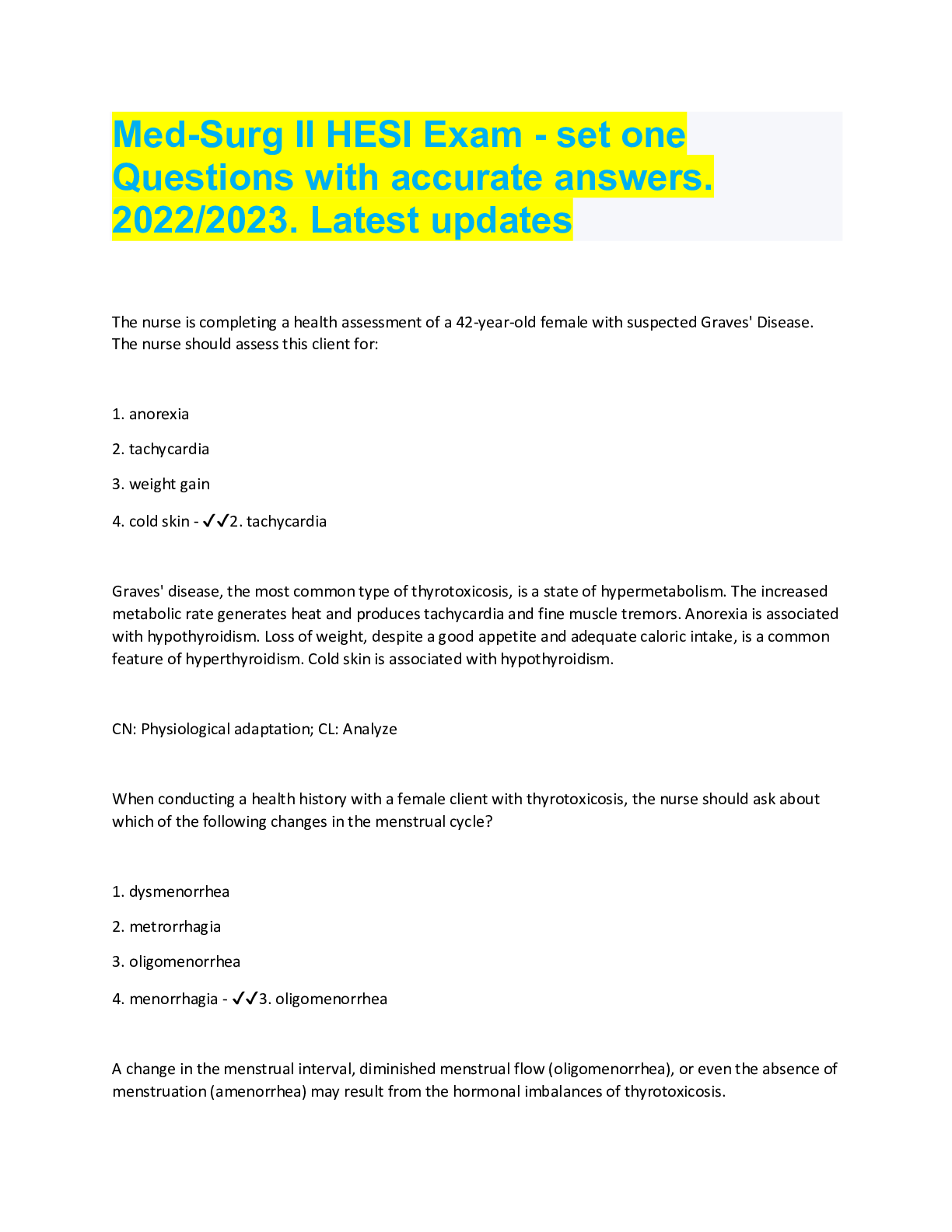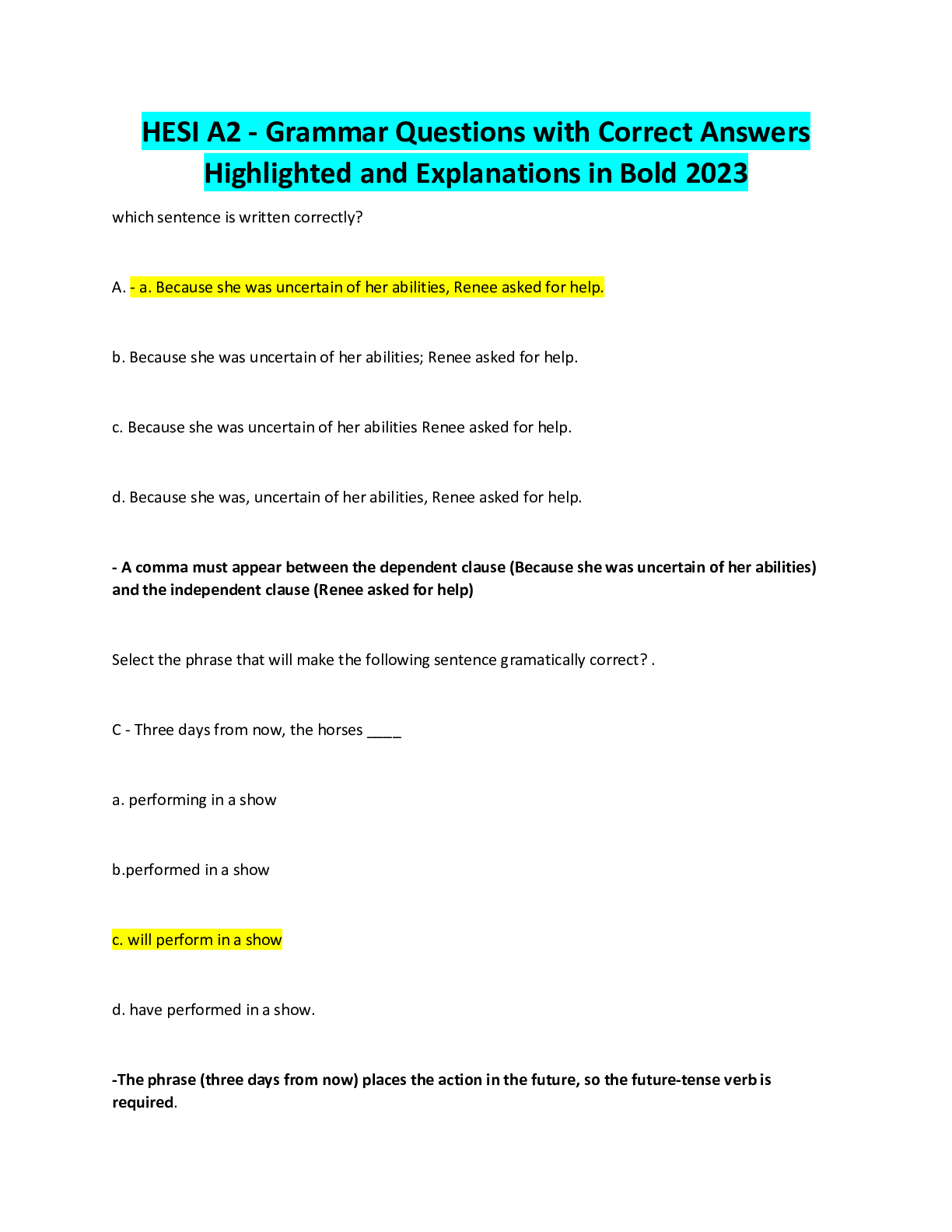*NURSING > HESI > (Complete Answered) neuro - HESI (evolve) A+. All Questions with accurate answers, rated A (All)
(Complete Answered) neuro - HESI (evolve) A+. All Questions with accurate answers, rated A
Document Content and Description Below
(Complete Answered) neuro - HESI (evolve) A+. All Questions with accurate answers, rated A After sustaining a head trauma, a client reports hearing ringing noises. Which area should the nurse ass... ess further? Frontal lobe Occipital lobe Sixth cranial nerve (abducens) Eighth cranial nerve (vestibulocochlear) - ✔✔Eighth cranial nerve (vestibulocochlear) A client is admitted to the hospital after sustaining a head injury. Which is the most reliable sign of increased intracranial pressure the nurse can monitor for? Rise in respiratory rate Narrowing of pulse pressure Decrease in the level of consciousness Increase in the diastolic blood pressure - ✔✔Decrease in the level of consciousness In caring for the client with burr holes for a subdural hematoma postoperatively on day 2, the nurse notes the client has an increased temperature to 101.3 F° (38.5° C). What does the nurse understand about this reaction? This is a normal assessment for the client with a subdural hematoma. This is a normal reaction day 2 postoperatively, and the nurse will administer acetaminophen as prescribed by the healthcare provider. Because the client has burr holes, this is not an accurate measurement. The client is exhibiting signs of an infection, and the healthcare provider needs to be notified. - ✔✔The client is exhibiting signs of an infection, and the healthcare provider needs to be notified. A client who had a cerebrovascular accident (also known as a "brain attack") becomes incontinent of feces. What is the most important nursing action to support the success of a bowel training program? Using medication to induce elimination Adhering to a definite time for attempted evacuations Considering previous habits associated with defecation Timing of elimination to take advantage of the gastrocolic reflex - ✔✔Adhering to a definite time for attempted evacuations A client sustains a vertebral fracture at the T1 level and is admitted to the emergency department. During a detailed neurologic assessment, the nurse expects to identify which clinical manifestation? Difficulty breathing Inability to move the lower arms Normal biceps reflexes in the arms Loss of pain sensation in the hands - ✔✔Normal biceps reflexes in the arms Which cranial nerve damage may lead to a decrease in the client's olfactory acuity? Cranial nerve I Cranial nerve X Cranial nerve V Cranial nerve VIII - ✔✔Cranial nerve I An older client is diagnosed with Alzheimer disease. For which clinical manifestations should the nurse assess the client? Loss of recent memory Focused attention span Perceptual disturbances Willingness to accept change Difficulty learning something new - ✔✔Loss of recent memory Perceptual disturbances Difficulty learning something new After a cerebrovascular accident (also known as brain attack) a client is unable to differentiate between heat or cold and sharp or dull sensory stimulation. What lobe of the brain should the nurse conclude is likely affected? Frontal Parietal Occipital Temporal - ✔✔Parietal A male client with a brain attack (cerebrovascular accident) has regained control of bowel movements but still is incontinent of urine. To help reestablish bladder control, what should the nurse encourage the client to do? Assume a standing position for voiding. Void every four hours and attempt to hold urine between set times. Attempt to void more frequently in the afternoon than in the morning. Drink a minimum of 4 L of fluid daily and divide it equally among the hours while awake. - ✔✔Assume a standing position for voiding. A client comes into the emergency department with neurologic deficits after falling off a ladder. Which client assessment will the nurse perform for the Glasgow Coma Scale? Breathing patterns Deep tendon reflexes Eye accommodation to light Motor response to verbal commands - ✔✔Motor response to verbal commands The nurse is performing a neurologic assessment on a client and is completing the Glasgow Coma Scale (GCS). What components make up this assessment tool? Best verbal response Best pupillary response Best motor response Best eye-opening response - ✔✔Best verbal response Best motor response Best eye-opening response When a disaster occurs, the nurse may have to first treat mass hysteria that is indicated by what response? Panic Coma Euphoria Depression - ✔✔Panic A client has a supratentorial craniotomy for a tumor in the right frontal lobe of the cerebral cortex. Which position does the nurse recognize is the most appropriate for this client postoperatively? Semi-Fowler with knee gatch elevated Flat on one side with the neck maintained in alignment with a small pillow Head of the bed elevated 30 to 45 degrees with the neck in neutral alignment Head of the bed elevated 20 degrees with the head turned to the operative side - ✔✔Head of the bed elevated 30 to 45 degrees with the neck in neutral alignment A client with quadriplegia is placed on a tilt table daily. The client asks why the angle of the head of the table is gradually increased. How should the nurse respond? It facilitates turning. This prevents pressure ulcers. It promotes hyperextension of the spine. This limits loss of calcium from the bones. - ✔✔This limits loss of calcium from the bones. A client comes into the emergency room (ER) after hitting his head while playing basketball. He is alert and oriented. Which is a priority nursing intervention? Assess full range of motion (ROM) to determine extent of injuries. Call for an immediate head computed tomography (CT). Immobilize the client's head and neck. Open the airway with the head-tilt chin-lift maneuver. - ✔✔Immobilize the client's head and neck. A nurse is providing instructions to a client with glaucoma. Which statements made by the client indicate the nurse needs to intervene? "I should take stool softeners." "I can wear loose collar shirts." "I should refrain from sneezing and coughing." "I can lift objects that weigh more than 10 lbs (4.5 kg)." "I should keep my head in a dependent position." - ✔✔"I can lift objects that weigh more than 10 lbs (4.5 kg)." "I should keep my head in a dependent position A client has expressive aphasia. The client's family members ask how they can help the client regain as much speech function as possible. Which information should the nurse share with the family? [Show More]
Last updated: 2 years ago
Preview 1 out of 26 pages

Buy this document to get the full access instantly
Instant Download Access after purchase
Buy NowInstant download
We Accept:

Reviews( 0 )
$8.00
Can't find what you want? Try our AI powered Search
Document information
Connected school, study & course
About the document
Uploaded On
Oct 05, 2022
Number of pages
26
Written in
Additional information
This document has been written for:
Uploaded
Oct 05, 2022
Downloads
0
Views
117











_merged.png)







